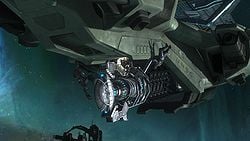Slipspace drive: Difference between revisions
From Halopedia, the Halo wiki
No edit summary |
Flawedspirit (talk | contribs) (→Human) |
||
| Line 10: | Line 10: | ||
==Human== | ==Human== | ||
{{Main|Shaw-Fujikawa Translight Engine}} | {{Main|Shaw-Fujikawa Translight Engine}} | ||
Developed in [[2291]] by the physicists [[Tobias Fleming Shaw]] and [[Wallace Fujikawa]], the Shaw-Fujikawa Translight Engine generates ruptures by using high-power cyclic particle accelerators to generate microscopic black holes. | Developed in [[2291]] by the physicists [[Tobias Fleming Shaw]] and [[Wallace Fujikawa]], the Shaw-Fujikawa Translight Engine generates ruptures by using high-power cyclic particle accelerators to generate microscopic black holes. Throughout much of the [[Human-Covenant War]], the technology was still limited and jumps typically took months or over half a year. | ||
By the end of the war, human advances in science and engineering, as well as captured Forerunner technology allowed for the construction of slipspace drives almost on par with those of the Covenant. The [[UNSC Infinity|UNSC ''Infinity'']] was capable of making slipspace transitions within an accuracy of one kilometer, and within one second of expected arrival time. | |||
==Covenant== | ==Covenant== | ||
Revision as of 23:37, March 24, 2013
A Slipspace drive is a device designed to make transitions in and out of an alternate plane known as slipstream space, allowing faster-than-light travel.
Overview
A slipspace drive functions by creating ruptures between normal space and slipspace.[1] The nonstandard physics of slipspace allow it to be used as a shortcut realm, facilitating interstellar travel between distant regions in reasonable time.
A slipspace drive does not actually "accelerate" a spacecraft through slipstream space; this is performed by the ship's conventional reaction thrusters. Thus, ships with more powerful conventional engines are also faster within the slipstream.[2] As astrogation, the coordination of slipspace jumps, cannot be successfully done by a human, the calculations involved in a jump are done by a navigation computer or an AI.[3]
Human
- Main article: Shaw-Fujikawa Translight Engine
Developed in 2291 by the physicists Tobias Fleming Shaw and Wallace Fujikawa, the Shaw-Fujikawa Translight Engine generates ruptures by using high-power cyclic particle accelerators to generate microscopic black holes. Throughout much of the Human-Covenant War, the technology was still limited and jumps typically took months or over half a year.
By the end of the war, human advances in science and engineering, as well as captured Forerunner technology allowed for the construction of slipspace drives almost on par with those of the Covenant. The UNSC Infinity was capable of making slipspace transitions within an accuracy of one kilometer, and within one second of expected arrival time.
Covenant
Being more technologically advanced than humanity, the Covenant have numerous advantages in slipspace propulsion systems. Whilst the Shaw-Fujikawa engine is said to “punch” a hole between realms using brute force, Covenant engines instead take a small rupture and delicately enlarge it with surgical precision. This allows the latter to execute far more accurate slips.[4] Covenant slipspace drives are often referred to as "jump drives".[5]
In addition to their more powerful thruster engines, it has been theorized by the UNSC that Covenant drives generate several "microjumps" within a single slipspace transition to measure the dilation involved in a jump, allowing them to reach their destinations faster.[6]
Covenant drives are generally more flexible and powerful than those of humans. They have thrice been seen to execute in-atmosphere slipspace transitions[7][8] (although the first time the drive in question was controlled by a human AI). In addition, Covenant drives can execute successful slips even if underpowered.
Forerunner
Forerunner understanding of the mechanics of slipspace far exceeded that of the UNSC or the Covenant. While little is know of the inner workings of Forerunner drives, they used "slipspace flakes" chipped from the Slipspace core, a crystal held in a location only known to the Master Builder.[9]
Sources
- ^ Halo: The Fall of Reach, page 141
- ^ Halo: Contact Harvest, Page 23
- ^ Halo: Contact Harvest, page 96
- ^ Halo: First Strike, page 86
- ^ Halo: Contact Harvest, page 136
- ^ Halo: First Strike (2010), Tug o' War
- ^ Halo: First Strike
- ^ Halo 2, level Delta Halo
- ^ Halo: Cryptum, page 124
